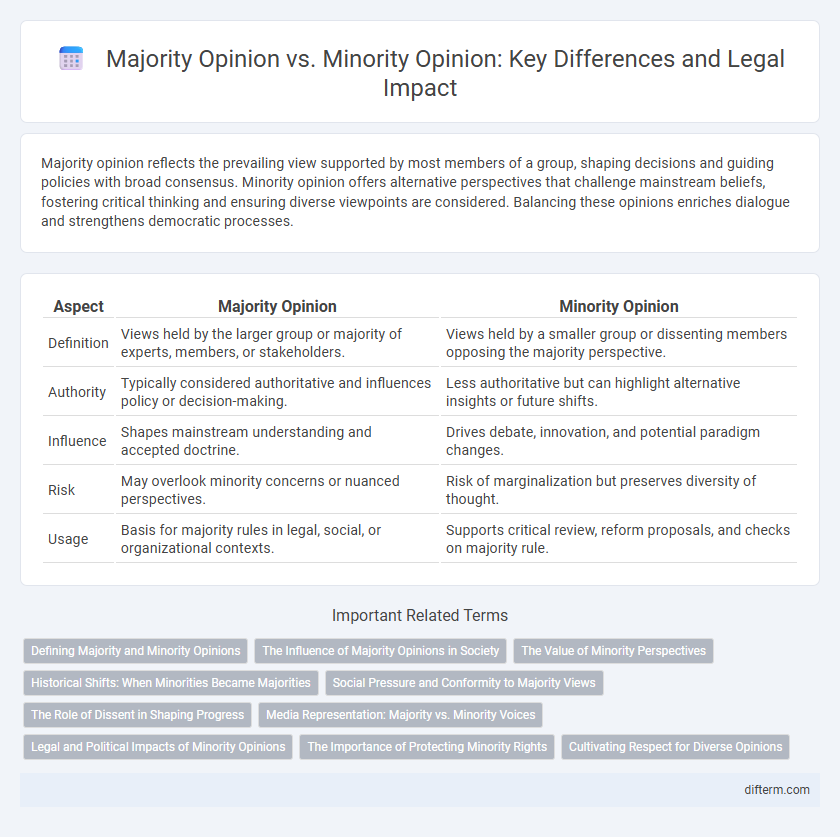Majority opinion reflects the prevailing view supported by most members of a group, shaping decisions and guiding policies with broad consensus. Minority opinion offers alternative perspectives that challenge mainstream beliefs, fostering critical thinking and ensuring diverse viewpoints are considered. Balancing these opinions enriches dialogue and strengthens democratic processes.
Table of Comparison
| Aspect | Majority Opinion | Minority Opinion |
|---|---|---|
| Definition | Views held by the larger group or majority of experts, members, or stakeholders. | Views held by a smaller group or dissenting members opposing the majority perspective. |
| Authority | Typically considered authoritative and influences policy or decision-making. | Less authoritative but can highlight alternative insights or future shifts. |
| Influence | Shapes mainstream understanding and accepted doctrine. | Drives debate, innovation, and potential paradigm changes. |
| Risk | May overlook minority concerns or nuanced perspectives. | Risk of marginalization but preserves diversity of thought. |
| Usage | Basis for majority rules in legal, social, or organizational contexts. | Supports critical review, reform proposals, and checks on majority rule. |
Defining Majority and Minority Opinions
Majority opinions represent the collective judgment or decision supported by more than half of the members within a group, reflecting the dominant perspective in legal or social contexts. Minority opinions, often termed dissenting opinions, articulate the reasoning of judges or individuals who disagree with the majority, highlighting alternative interpretations or concerns. Defining these opinions is crucial for understanding the dynamics of decision-making processes and for recognizing the influence of dissent in shaping future jurisprudence or societal change.
The Influence of Majority Opinions in Society
Majority opinions often shape societal norms by establishing widely accepted beliefs and behaviors, influencing public policy, and driving cultural trends. The pressure to conform to majority views can marginalize minority perspectives, limiting diversity in thought and innovation. Understanding the dominance of majority opinions is crucial for fostering inclusivity and ensuring balanced representation in democratic decision-making processes.
The Value of Minority Perspectives
Minority opinions often provide innovative solutions and critical insights that challenge prevailing assumptions, driving social progress and intellectual diversity. These perspectives highlight overlooked issues and offer alternative approaches that enrich democratic discourse and decision-making. Embracing minority viewpoints fosters inclusivity and resilience within societies by promoting tolerance and understanding.
Historical Shifts: When Minorities Became Majorities
Historical shifts show that majority opinions are not fixed and can transform as minority groups gain influence through social, political, or cultural changes. Instances such as the civil rights movement and women's suffrage demonstrate how once marginalized voices became dominant, reshaping societal norms and legal frameworks. These transitions highlight the fluid nature of public consensus and the potential power of minority opinions to redefine majority beliefs over time.
Social Pressure and Conformity to Majority Views
Social pressure significantly influences individuals to conform to majority opinions, often suppressing minority viewpoints despite their potential validity. Studies in social psychology reveal that conformity ensures group cohesion but limits critical dissent and innovation. This dynamic underscores the importance of creating environments where minority opinions can be expressed without fear of ostracism.
The Role of Dissent in Shaping Progress
Dissent challenges the conformity of majority opinion, fueling innovation and societal advancement by introducing alternative perspectives. Minority opinions often serve as catalysts for critical reflection, encouraging deeper analysis and preventing stagnation within dominant paradigms. Historical progress frequently traces back to the persistence of dissenting voices reshaping prevailing norms and policies.
Media Representation: Majority vs. Minority Voices
Media representation often amplifies majority opinions through widespread coverage and dominant narratives, marginalizing minority voices and limiting public awareness of diverse perspectives. This imbalance can perpetuate stereotypes and social inequalities by restricting the visibility of minority experiences and viewpoints. Elevating minority opinions in media platforms enhances democratic discourse and fosters a more inclusive understanding of societal issues.
Legal and Political Impacts of Minority Opinions
Minority opinions in legal settings often serve as catalysts for future judicial change by highlighting alternative interpretations of law and promoting legal evolution. Politically, they provide a voice for dissenting views, influencing public discourse and policy development by challenging prevailing majority perspectives. These opinions preserve democratic principles by ensuring that diverse viewpoints remain part of the institutional record, potentially shaping legislative reform and judicial precedent over time.
The Importance of Protecting Minority Rights
Protecting minority rights ensures a balanced democratic society where diverse viewpoints are respected and innovation thrives. Majority opinion can often overshadow minority perspectives, risking marginalization and social injustice without adequate safeguards. Upholding minority rights fosters inclusion and prevents the tyranny of the majority, thereby strengthening social cohesion and equity.
Cultivating Respect for Diverse Opinions
Respecting diverse opinions fosters a more inclusive and thoughtful society where both majority and minority voices contribute to collective understanding. Majority opinion often reflects common values, but minority perspectives challenge norms and drive innovation by highlighting alternative viewpoints. Cultivating an environment that values all opinions promotes critical thinking, empathy, and balanced decision-making.
majority opinion vs minority opinion Infographic

 difterm.com
difterm.com